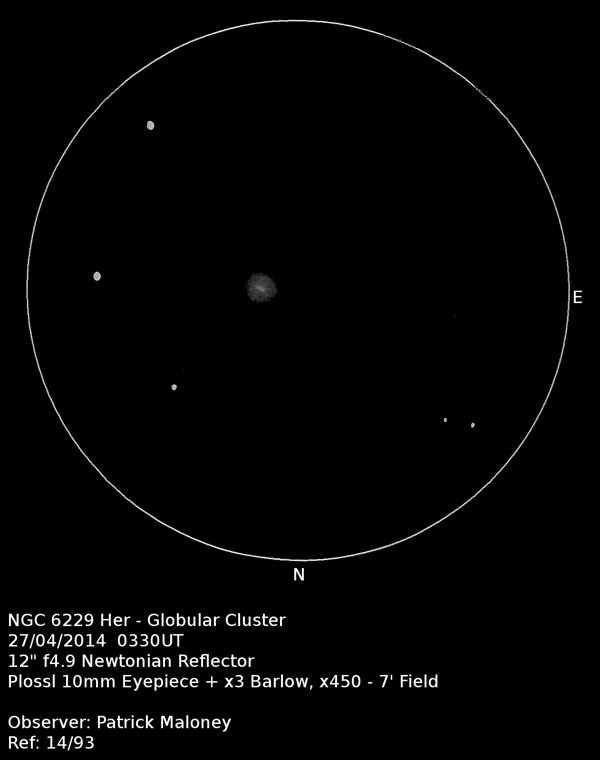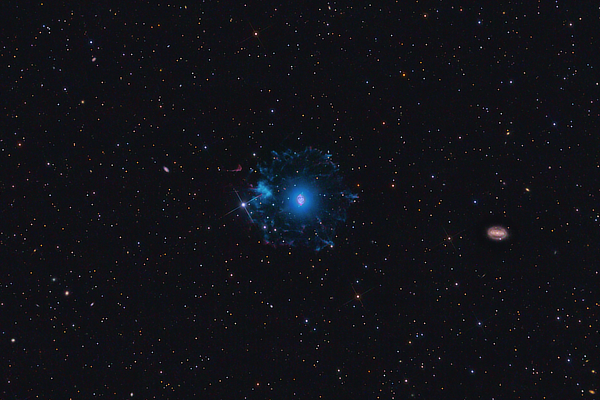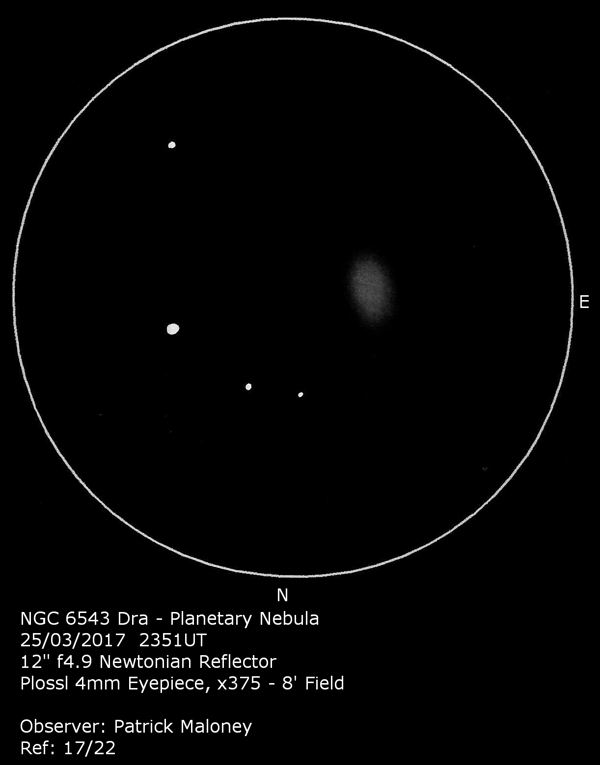NGC 6229 and NGC 6543
June 2023 - Nebula and Cluster of the Month
The northern Milky Way begins to swing back into view during June. This month also provides the brightest and shortest night-times of the northern year. For those of us plagued by light pollution, this makes little difference, as we observe through a permanent, artificial twilight anyway.
We’re going to be looking at a couple of objects that are far more accessible to northern observers than those featured in recent columns. On offer this month are a small globular cluster in Hercules, NGC 6229, and a bright planetary nebula in Draco, NGC 6543.
NGC 6229 lies in northern Hercules, about halfway between the stars 42 & 52 Herculis. It shines at magnitude 9.4 and can be seen fairly easily, even against a twilit sky, with only modest equipment. A dark sky will show it to 10x50 binoculars.
It was discovered by William Herschel on 12th May 1787. He described it as Very bright. Round. 4’ diameter. Almost equally bright with a faint, resolvable margin.

This was at the time when Herschel believed that all nebulae would ultimately succumb to resolution into stars, including planetary nebulae. He placed NGC 6229 in his fourth category, Planetary Nebulae, as number 50. It wasn’t until 1790 that an observation of NGC 1514 began to turn his thinking towards the fact that some nebulae might not be made up of stars at all. At this point in his career, this object looked like what he called ‘planetary nebulae’, so into that category it went.
We now know that NGC 6229 is actually a globular cluster. It lies at a distance of almost 32,000 parsecs (105,000 light-years) which is about five times further away from us than its near-neighbour in Hercules, M13. Like an increasing number of globular clusters, it is suspected of being the core of a dwarf spheroidal galaxy previously consumed by the Milky Way.
The globular cluster is about 1.6’ across. Its diameter is often quoted at around 4’, but this is inclusive of all the faintest outer stragglers that visual observers have no chance of seeing. If you go out to look at it, look at it carefully and see if you can understand why Herschel thought it was a planetary nebula, always bearing in mind that there was no scientific definition in play at the time. I think it’s quite understandable. The brightest star in the cluster is magnitude 15.5, so unless you have a pretty large telescope at your disposal, you’re not going to resolve it.
I include my own observation here, made with a 12” (300mm) Newtonian reflector. I described it as follows: Bright, round and with some mottling but otherwise unresolved at x150. Gradually brighter towards the centre. x450 gives a hint of resolution and shows the surface brightness of the globular to be irregular. The centre may be slightly elongated.

Our second object for this month lies further north, in Draco. NGC 6543 is a bright planetary nebula, magnitude 8.9, so again should punch through that annoying twilight.
It’s another Herschel discovery. He found it on the night of 15th February 1786, writing: A planetary nebula. Very bright. Has a disc of about 35” diameter but very ill-defined edge. With long attention a very bright, well defined round centre becomes visible.

Although distances to planetary nebulae are notoriously vague and uncertain, most authorities seem to agree on a distance of 3,300 light-years for NGC 6543.
It is a very complex nebula with folds and convolutions whose origin is far from clear. Two possible theories are that the central star has a strong, twisting magnetic field or that there is an unseen companion star warping the nebula.
Clearly visible in deep images is a large, outer region of very faint nebulosity, about 6’ across, which may be detected visually under optimal conditions. The outer nebulosity has a chunky appearance around its edge, and two of the brighter knots have earned themselves their own catalogue entries.
The largest and brightest was first seen by E. E. Barnard on 24th April 1900. It was catalogued in the Second Index Catalogue as IC 4677, where its description is very small, faint
. With a large telescope, very dark skies and an OIII filter, it can be seen as an elongated streak 1.5’ west of NGC 6543.
A second, much fainter blob also has its own catalogue entry. This blob is 2.5’ south of the centre of NGC 6543 and is incorrectly listed as a galaxy in the PGC/LEDA catalogue as PGC 2688853.
More visible than either of these is the 13.6 magnitude galaxy NGC 6552, 9’ to the east of the planetary nebula.
I have observed NGC 6543 on a number of occasions and I have included an observation from 2017, which gives a good impression of what can be seen under less-than-ideal circumstances.

Many observers see green in this nebula. To me, it always appears blue.
I described the object on that night as Very bright, large and oval. More or less uniform in brightness, but slightly darker at the edge. There is a very faint outer envelope. To me, it has a bluish colour. The OIII filter makes little difference. Lovely.
| Object | RA | Dec | Type | Magnitude |
|---|---|---|---|---|
| NGC 6229 | 16h 46m 59s | +47° 31’ 42” | Globular cluster | 9.4 |
| NGC 6543 | 17h 58m 33s | +66° 38’ 04” | Planetary nebula | 8.9 |